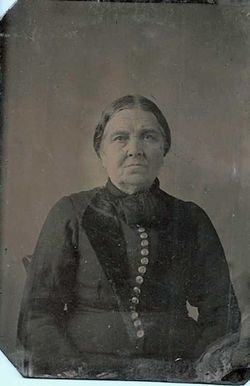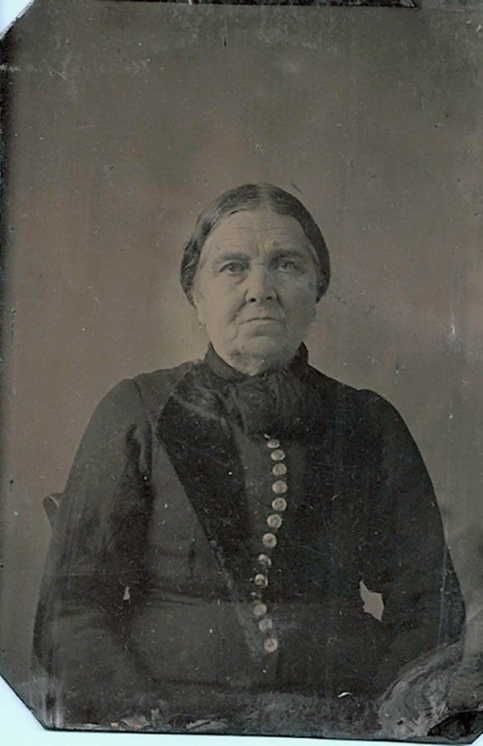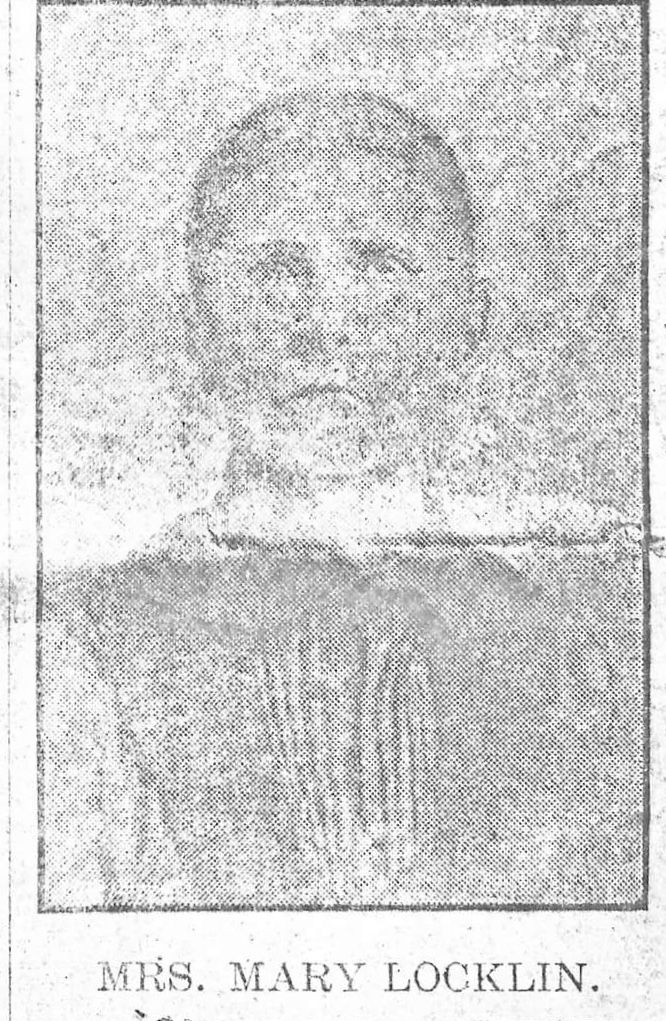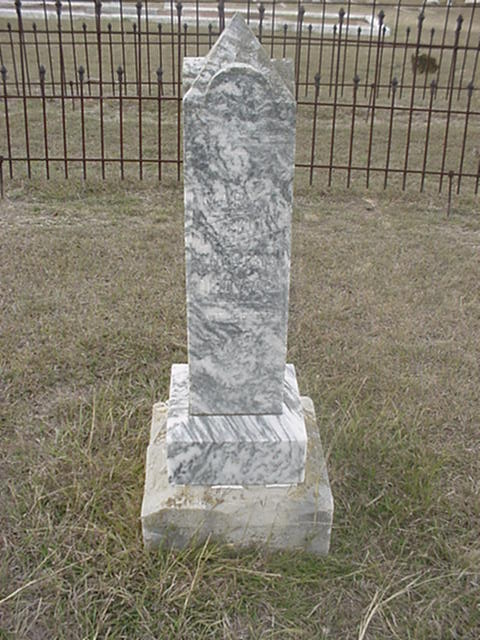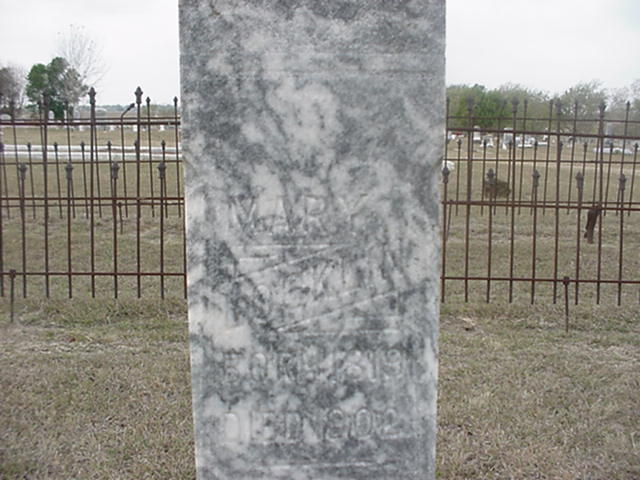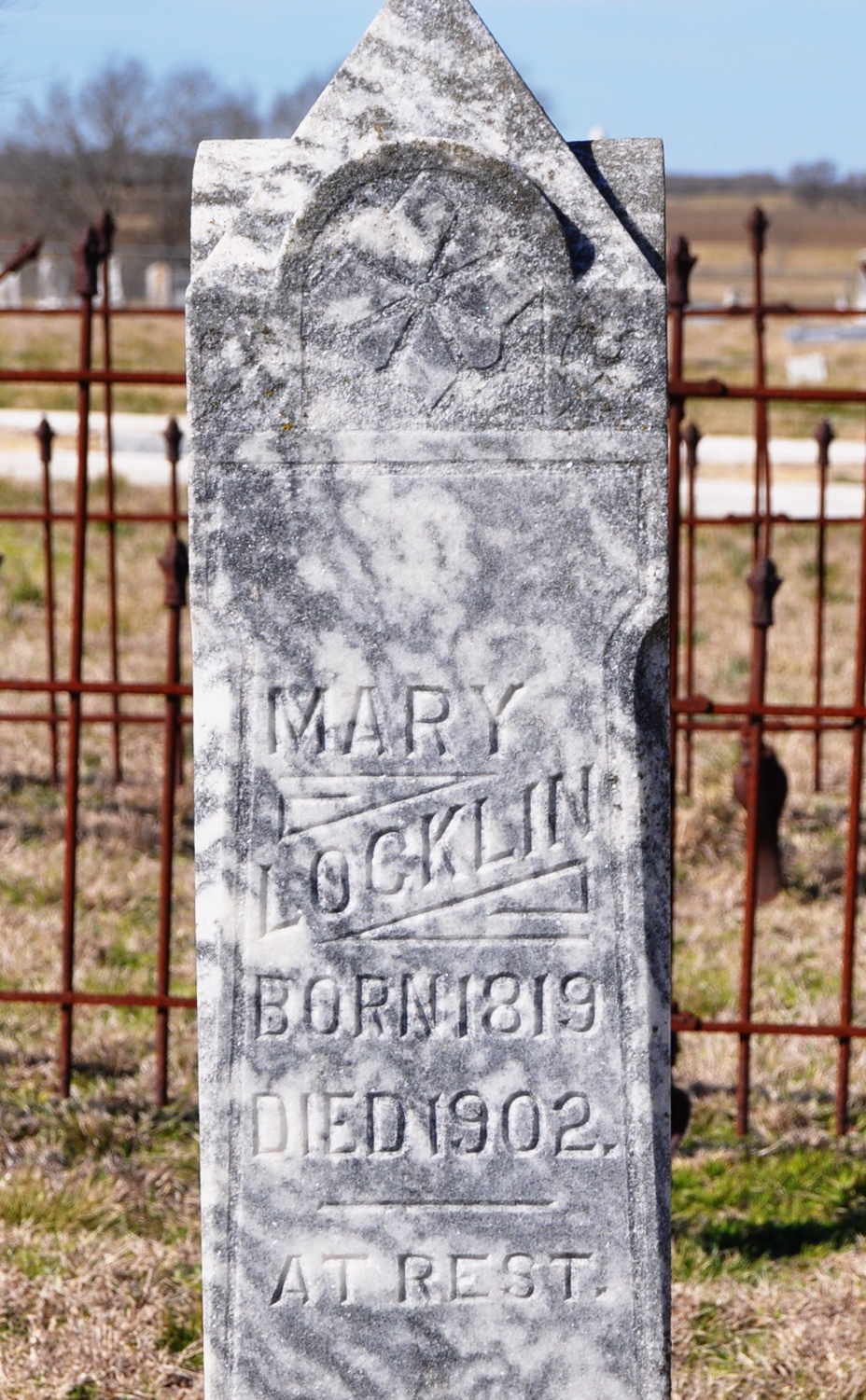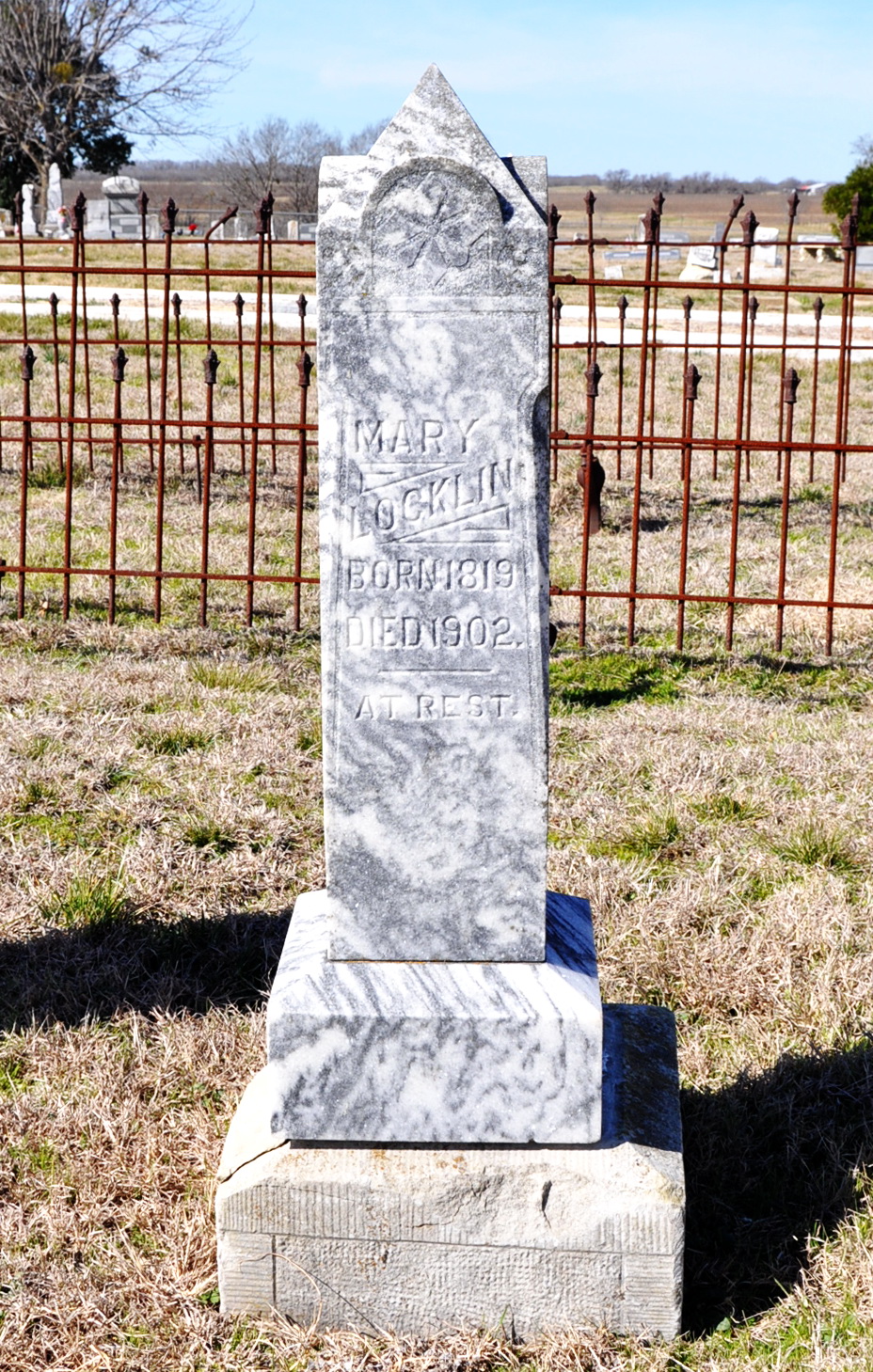Mary Elizabeth Fokes, born in Pensacola, Escambia Co., FL - Daughter of John Fokes Sr and Abagail McLennan.
Sister of John Jr, Daniel, Charles Neal, Catherine and Permillia Ann Fokes.
Mary married, before 1843, James H Fulcher, a son of Francis Leonder & Frances Elizabeth Fulcher. After the death of James on 17 Mar 1852, Mary married, 25 Oct 1852 in Milam Co., TX, Alteman Livingston Locklin, a son of William Lawson Locklin Sr and Nancy Mercer.
Mother of (by James) Emily A, John Francis, James Henry "Bud" and Abegail Permillia Fulcher.
Mother of (by Alteman) Samuel Griffith, Mary Maranda, William Hardeman and Charles Franklin "Frank" Locklin.
Granddaughter of John McLennan and Catherine McKinnon.
Mary died in San Gabriel, Milam Co., TX.
~♥~ Paternal 2nd Great Grandmother ~♥~
~~~~~~~~~~~~~ † ~~~~~~~~~~~~~
THE THORNDALE THORN
VOL. 2, VOL. 14
THORNDALE, MILAM COUNTY, TEXAS
DEC. 26, 1902
[Originally published in the Cameron Herald, 1896. Also published in Volume X, of McLean, PAPERS CONCERNING ROBERTSON'S COLONY IN TEXAS, pgs 140-144. Republished, Frontier Times, Bandera, Texas, Volume 8--No. 13 (October, 1931), pp. 588-592.]
BIOGRAPHICAL
SKETCH OF THE LIFE OF ONE OF
MILAM COUNTY'S PIONEERS
Mrs. Mary Locklin died at the home of her son, J.H. Fulcher, six miles north of Thorndale, on Monday morning, Dec. 1, 1902 at the age of 83 years. Deceased came to this country early in 1835 and settled where she died. Her mother, Mrs. Abigail Fokes located her head-right league on the south side of the San Gabriel River and which is now in a fine state of cultivation and is owned and cultivated by her descendants.
Following is a brief history of the trials of Mrs. Locklin and others who attempted the settlement of Milam and adjoining counties in the early days as told by the subject of this sketch to Mr. H.N. Roberts and published in the Cameron Herald about six years ago.
Sometime in the month of December, 1834, a three-mast schooner sailed from Pensacola, Fla., bound for Texas with emigrants, some of whom were destined to figure more or less conspicuously in the early history of that region of country which afterwards became Milam and other counties of Texas. This schooner, the "Caledon[i]a," was owned in large part and commanded by Aaron C. Dodd, who eventually settled on the San Gabriel, a short distance below the site of the present village of San Gabriel. He was one of the early judges of this county, and died in Cameron. The Caledonia's passengers, all emigrants who came to settle in this then wilderness, were Daniel Robinson, Sr., Neil, John and Laughlin McLennan and their families; Abigail Fokes, a widow, and her three sons and three daughters. March 1, 1835, the Caledonia entered the mouth of the Brazos river, and sailing up the stream ended her voyage at Columbia.
After a needed rest, for the voyage had been a long one, tedious and rough, these emigrants procured teams and moving westward, came to a final halt at "Sugar Loaf," since called McLennan's Bluff, not far from old Nashville, on the Brazos, near the mouth of Little River. They did not all immediately reach that stopping place, but their journey thither was devoid of interest. The heads of families lost no time in locating land and the beginning of improvements. Dan Robinson [Daniel Robertson] and Abigail Fokes located their head right certificates side by side on the San Gabriel, some six miles north of where Thorndale now stands, Neil and Laughlin McLennan settling on Pond Creek, northeast of the present site of Cameron. They built houses and went to work improving their lands. Neil McLennan afterwards moved further up the Brazos and gave his name to McLennan County. Of his children, John will be remembered by citizens of Cameron as the father of Mrs. Pinkney S. Ford. He was one of the pioneers of Cameron, helping to make the first survey of the town site and adjacent lands.
From one of the daughters of Abigail Fokes the writer received data for this bit of history. She was about fourteen years old when her mother moved to Texas, and although now well advanced in years, her memory is remarkably good, retaining in detail the occurrences of those early days. She is now the wife of Alteman L. Locklin, well known throughout the country, and still lives upon her portion of the Abigail Fokes league, one mile south of the San Gabriel village. Of the other children of Mrs. Fokes, the two daughters are living -- Catherine Anderson, with Mrs. Locklin, and Mrs. George W. Guthrie, near Lexington in Lee County. The sons are dead. John and Daniel were never married, while Charles, who died in the Confederate army, was the father of W.F. Fokes, now county judge of Irion County, and Charles H. Fokes, still living in Milam County and well known.
Present citizens of this now well settled and civilized region can scarcely realize conditions as they existed sixty years ago. Where beautiful farms, thriving cities and towns about; where railroads and telegraph lines now stretch away in every direction, and all the luxuriant beauties of a high state of civilization meets the eye, was a vast wilderness over which roamed the wild Indian, and herds of buffalo, elk and deer ranged virtually unmolested.
At the time of which I write -- the summer and fall of 1835 -- the Indians were, ostensibly, at peace with the few white settlers, though this peace was deceptive and not to be depended upon, and a block house and other defenses were provided at Nashville, to which the people could flee from their farms when danger threatened.
While our emigrants were pursuing their works of improvement the Indians were hatching their deviltry and came down upon them without warning, burning their houses, killing stock, destroying property and murdering defenseless women and children.
At a time when Dan Robinson, Mrs. Fokes and sons and others were away, looking after the location of land, a raid was made upon the Pond Creek settlement. The daughters of Mrs. Fokes were with the family of Neil McLennan, while their aged and blind grandmother, Catharine McLennan [Catherine McKinnon McLennan], the mother of Mrs. Fokes and the McLennans with the family of Laughlin about a mile away on the north side of Pond Creek. The first intimation the women and children at Neil's had of the trouble, was seeing a column of smoke in the direction of Laughlin McLennan's house. In absence of the men they were unable to learn the truth, but too soon it was known; the dwelling house had been fired by Indians. The red fiends first came upon Laughlin where he was at work making rails in the bottom, and shot him to death with arrows, twenty-five of which were sticking into and through his body when found. They then advanced on the house where Aunt Peggy, Laughlin's wife, her three boys and aged mother were awaiting the return of the son, husband and father to dinner, and killed the old lady by a blow on the head with an axe and cast her body into the house which they set on fire. After wantonly destroying everything they could, killing cows, calves and chickens, they left, taking the distracted mother and her boys with them. When the men folks returned to Neil's house they knew that the war had begun, but knowing not the force with which they would have to contend, they could do nothing but provide for the safety of those yet unharmed, and reconnoiter the strength of the enemy. The women and children were hidden out in the bushes, only creeping back to the house and cowpen at night for food. During this time these men scouted the country for the purpose of ascertaining the extent of the calamity that had befallen the settlement. For some reason the Indians did not molest any other place in the settlement at that time, and left with their prisoners.
The McLennan boys captured were John, aged 8; Neil, about 6, and Daniel, about 4 years. The mother was never recovered, but after several years died in captivity. The boys were traded from tribe to tribe and the eldest, John, was returned to his relatives after being with the Indians ten years. Old citizens of Milam, Burleson and McLennan counties will remember "Bosque John," as he was called. He had become well Indianized by his long residence among the redskins, and for some time pined for his dusky 'mamma' and 'brothers' as he had been taught to call them, and for a time he strongly objected to the restraints of life among the whites, trying sometimes to run away to the tribe that had adopted him. But he finally became reconciled and his memory reclaimed. He was later employed as an interpreter for the Indians. When about thirty years of age he was killed presumably by a fall from the window of the court house in Waco, but there were many who believed that he was murdered for the pay for his services that he had drawn a short while before. The second son, Neil, was not returned to his relatives, or to this vicinity at least, while the younger, Daniel, died with the Indians.
About the time of these raids John McLennan, with his family and others, settled on the Fokes and Robinson leagues on the San Gabriel. The Indians raided their camp, while the men were absent. They captured his wife, another Aunt Peggy, and binding her with a bridle rein, fell to work pillaging and destroying the camp. Among their effects, in boxes they had brought from Florida, there was a quantity of whiskey and strong medicines. They fell to guzzling down the spirits, and after a short season of wild orgies and demoniac yelling and capering, they were overcome by their potations and were drunk. Aunt Peggy then released herself and taking the children, who were so small the Indians had not bound them, she went across the river and found a hiding place in the top of a cottonwood tree surrounded by a luxuriant growth of weeds. Here they remained for several days and nights, afraid to return from their hiding place, except at night, when they would creep out to the ruined camp and gather corn that the Indians had scattered over the ground, for food. When the men returned and found the camp dismantled and abandoned they thought the women and children had been carried away captives, and they went to the other settlements for help. Aunt Peggy saw the rescuing party when it arrived, but was so crazed by the suffering and fright she had undergone that she did not know them, but thought them enemies. They called her by name, but she ran and had to be run down and captured before she could be convinced that they were her friends.
The danger of such raids was so great that the settlement on the San Gabriel had to be abandoned for some years, the settlers keeping near together at Nashville and other places.
In 1844 Jesse and Peter Mercer moved on the Abigail Fokes league, mistaking that land for the Mercer location, which, in fact, was further west in Williamson county, a location that was afterwards the subject of prolonged litigation, which came to an end but a few years ago. They built what was then known as the Mercer Fort, on the bluff above the San Gabriel, near the line between the Abigail Fokes and Dan Robinson leagues, and not the line between the farms of L.L. Lee and J.H. Fulcher. Here the Indians came down upon the settlement. Peter Mercer saw them approaching and hurried his wife with Jesse's three children and some Negro children, into hiding in the bushes across the river. From their place of concealment Mrs. Mercer could hear much of what occurred at the fort, including the shots which killed her husband. As soon as Peter became certain that the Indians' intentions were hostile he fled, and as he went over the river bluff he was shot and killed. A young man named Orr was killed while running through the river, and a Negro boy about 16 years old met his death a short distance south of the fort. When darkness came Mrs. Mercer took her flock of children, she and the older ones carrying those too small to travel with the speed desirable, and made their way to the settlement at Nashville.
Abigail Fokes and her family moved to Burleson county, stopping on Davidson's Creek, some five miles from Caldwell, where they lived until it was safe to settle on her San Gabriel lands. There her daughter Mary, from whom this history is mainly obtained, was married to James Fulcher. Three children resulted from this union, only the eldest, J.H. Fulcher, better known as "Bud," is living, and the site of the old Mercer Fort is upon his farm and very near his residence. A daughter married Alf. B Lovelace, now living on the Fokes league, while the third child, a daughter, died at the age of 18, unmarried. After the death of James Fulcher, Aunt Mary, as she is affectionately known by a large circle of friends, married her second husband, A.L. Locklin.
This is but an outline of history that she helped make. There is much more and many details that I cannot at this time undertake to relate.
Many who know naught of this country save its present comfortable civilization, will find it difficult to realize the dangers, hardships and privations endured by the pioneers while making this civilization possible. Leaving their homes in the older states they came hundreds of miles to this wilderness, wrenched it from the murderous savage and scarcely less cruel Mexican, and paved the way to development and subjugation of the broad land that is now the Empire State of the Union. These early settlers are now few in number, and very soon they will all be gone, and as we enjoy the blessings their bravery, toil and suffering made possible, we should not forget the debt of gratitude due them, or fail to accord their mead of respect and appreciation.
Mary Elizabeth Fokes, born in Pensacola, Escambia Co., FL - Daughter of John Fokes Sr and Abagail McLennan.
Sister of John Jr, Daniel, Charles Neal, Catherine and Permillia Ann Fokes.
Mary married, before 1843, James H Fulcher, a son of Francis Leonder & Frances Elizabeth Fulcher. After the death of James on 17 Mar 1852, Mary married, 25 Oct 1852 in Milam Co., TX, Alteman Livingston Locklin, a son of William Lawson Locklin Sr and Nancy Mercer.
Mother of (by James) Emily A, John Francis, James Henry "Bud" and Abegail Permillia Fulcher.
Mother of (by Alteman) Samuel Griffith, Mary Maranda, William Hardeman and Charles Franklin "Frank" Locklin.
Granddaughter of John McLennan and Catherine McKinnon.
Mary died in San Gabriel, Milam Co., TX.
~♥~ Paternal 2nd Great Grandmother ~♥~
~~~~~~~~~~~~~ † ~~~~~~~~~~~~~
THE THORNDALE THORN
VOL. 2, VOL. 14
THORNDALE, MILAM COUNTY, TEXAS
DEC. 26, 1902
[Originally published in the Cameron Herald, 1896. Also published in Volume X, of McLean, PAPERS CONCERNING ROBERTSON'S COLONY IN TEXAS, pgs 140-144. Republished, Frontier Times, Bandera, Texas, Volume 8--No. 13 (October, 1931), pp. 588-592.]
BIOGRAPHICAL
SKETCH OF THE LIFE OF ONE OF
MILAM COUNTY'S PIONEERS
Mrs. Mary Locklin died at the home of her son, J.H. Fulcher, six miles north of Thorndale, on Monday morning, Dec. 1, 1902 at the age of 83 years. Deceased came to this country early in 1835 and settled where she died. Her mother, Mrs. Abigail Fokes located her head-right league on the south side of the San Gabriel River and which is now in a fine state of cultivation and is owned and cultivated by her descendants.
Following is a brief history of the trials of Mrs. Locklin and others who attempted the settlement of Milam and adjoining counties in the early days as told by the subject of this sketch to Mr. H.N. Roberts and published in the Cameron Herald about six years ago.
Sometime in the month of December, 1834, a three-mast schooner sailed from Pensacola, Fla., bound for Texas with emigrants, some of whom were destined to figure more or less conspicuously in the early history of that region of country which afterwards became Milam and other counties of Texas. This schooner, the "Caledon[i]a," was owned in large part and commanded by Aaron C. Dodd, who eventually settled on the San Gabriel, a short distance below the site of the present village of San Gabriel. He was one of the early judges of this county, and died in Cameron. The Caledonia's passengers, all emigrants who came to settle in this then wilderness, were Daniel Robinson, Sr., Neil, John and Laughlin McLennan and their families; Abigail Fokes, a widow, and her three sons and three daughters. March 1, 1835, the Caledonia entered the mouth of the Brazos river, and sailing up the stream ended her voyage at Columbia.
After a needed rest, for the voyage had been a long one, tedious and rough, these emigrants procured teams and moving westward, came to a final halt at "Sugar Loaf," since called McLennan's Bluff, not far from old Nashville, on the Brazos, near the mouth of Little River. They did not all immediately reach that stopping place, but their journey thither was devoid of interest. The heads of families lost no time in locating land and the beginning of improvements. Dan Robinson [Daniel Robertson] and Abigail Fokes located their head right certificates side by side on the San Gabriel, some six miles north of where Thorndale now stands, Neil and Laughlin McLennan settling on Pond Creek, northeast of the present site of Cameron. They built houses and went to work improving their lands. Neil McLennan afterwards moved further up the Brazos and gave his name to McLennan County. Of his children, John will be remembered by citizens of Cameron as the father of Mrs. Pinkney S. Ford. He was one of the pioneers of Cameron, helping to make the first survey of the town site and adjacent lands.
From one of the daughters of Abigail Fokes the writer received data for this bit of history. She was about fourteen years old when her mother moved to Texas, and although now well advanced in years, her memory is remarkably good, retaining in detail the occurrences of those early days. She is now the wife of Alteman L. Locklin, well known throughout the country, and still lives upon her portion of the Abigail Fokes league, one mile south of the San Gabriel village. Of the other children of Mrs. Fokes, the two daughters are living -- Catherine Anderson, with Mrs. Locklin, and Mrs. George W. Guthrie, near Lexington in Lee County. The sons are dead. John and Daniel were never married, while Charles, who died in the Confederate army, was the father of W.F. Fokes, now county judge of Irion County, and Charles H. Fokes, still living in Milam County and well known.
Present citizens of this now well settled and civilized region can scarcely realize conditions as they existed sixty years ago. Where beautiful farms, thriving cities and towns about; where railroads and telegraph lines now stretch away in every direction, and all the luxuriant beauties of a high state of civilization meets the eye, was a vast wilderness over which roamed the wild Indian, and herds of buffalo, elk and deer ranged virtually unmolested.
At the time of which I write -- the summer and fall of 1835 -- the Indians were, ostensibly, at peace with the few white settlers, though this peace was deceptive and not to be depended upon, and a block house and other defenses were provided at Nashville, to which the people could flee from their farms when danger threatened.
While our emigrants were pursuing their works of improvement the Indians were hatching their deviltry and came down upon them without warning, burning their houses, killing stock, destroying property and murdering defenseless women and children.
At a time when Dan Robinson, Mrs. Fokes and sons and others were away, looking after the location of land, a raid was made upon the Pond Creek settlement. The daughters of Mrs. Fokes were with the family of Neil McLennan, while their aged and blind grandmother, Catharine McLennan [Catherine McKinnon McLennan], the mother of Mrs. Fokes and the McLennans with the family of Laughlin about a mile away on the north side of Pond Creek. The first intimation the women and children at Neil's had of the trouble, was seeing a column of smoke in the direction of Laughlin McLennan's house. In absence of the men they were unable to learn the truth, but too soon it was known; the dwelling house had been fired by Indians. The red fiends first came upon Laughlin where he was at work making rails in the bottom, and shot him to death with arrows, twenty-five of which were sticking into and through his body when found. They then advanced on the house where Aunt Peggy, Laughlin's wife, her three boys and aged mother were awaiting the return of the son, husband and father to dinner, and killed the old lady by a blow on the head with an axe and cast her body into the house which they set on fire. After wantonly destroying everything they could, killing cows, calves and chickens, they left, taking the distracted mother and her boys with them. When the men folks returned to Neil's house they knew that the war had begun, but knowing not the force with which they would have to contend, they could do nothing but provide for the safety of those yet unharmed, and reconnoiter the strength of the enemy. The women and children were hidden out in the bushes, only creeping back to the house and cowpen at night for food. During this time these men scouted the country for the purpose of ascertaining the extent of the calamity that had befallen the settlement. For some reason the Indians did not molest any other place in the settlement at that time, and left with their prisoners.
The McLennan boys captured were John, aged 8; Neil, about 6, and Daniel, about 4 years. The mother was never recovered, but after several years died in captivity. The boys were traded from tribe to tribe and the eldest, John, was returned to his relatives after being with the Indians ten years. Old citizens of Milam, Burleson and McLennan counties will remember "Bosque John," as he was called. He had become well Indianized by his long residence among the redskins, and for some time pined for his dusky 'mamma' and 'brothers' as he had been taught to call them, and for a time he strongly objected to the restraints of life among the whites, trying sometimes to run away to the tribe that had adopted him. But he finally became reconciled and his memory reclaimed. He was later employed as an interpreter for the Indians. When about thirty years of age he was killed presumably by a fall from the window of the court house in Waco, but there were many who believed that he was murdered for the pay for his services that he had drawn a short while before. The second son, Neil, was not returned to his relatives, or to this vicinity at least, while the younger, Daniel, died with the Indians.
About the time of these raids John McLennan, with his family and others, settled on the Fokes and Robinson leagues on the San Gabriel. The Indians raided their camp, while the men were absent. They captured his wife, another Aunt Peggy, and binding her with a bridle rein, fell to work pillaging and destroying the camp. Among their effects, in boxes they had brought from Florida, there was a quantity of whiskey and strong medicines. They fell to guzzling down the spirits, and after a short season of wild orgies and demoniac yelling and capering, they were overcome by their potations and were drunk. Aunt Peggy then released herself and taking the children, who were so small the Indians had not bound them, she went across the river and found a hiding place in the top of a cottonwood tree surrounded by a luxuriant growth of weeds. Here they remained for several days and nights, afraid to return from their hiding place, except at night, when they would creep out to the ruined camp and gather corn that the Indians had scattered over the ground, for food. When the men returned and found the camp dismantled and abandoned they thought the women and children had been carried away captives, and they went to the other settlements for help. Aunt Peggy saw the rescuing party when it arrived, but was so crazed by the suffering and fright she had undergone that she did not know them, but thought them enemies. They called her by name, but she ran and had to be run down and captured before she could be convinced that they were her friends.
The danger of such raids was so great that the settlement on the San Gabriel had to be abandoned for some years, the settlers keeping near together at Nashville and other places.
In 1844 Jesse and Peter Mercer moved on the Abigail Fokes league, mistaking that land for the Mercer location, which, in fact, was further west in Williamson county, a location that was afterwards the subject of prolonged litigation, which came to an end but a few years ago. They built what was then known as the Mercer Fort, on the bluff above the San Gabriel, near the line between the Abigail Fokes and Dan Robinson leagues, and not the line between the farms of L.L. Lee and J.H. Fulcher. Here the Indians came down upon the settlement. Peter Mercer saw them approaching and hurried his wife with Jesse's three children and some Negro children, into hiding in the bushes across the river. From their place of concealment Mrs. Mercer could hear much of what occurred at the fort, including the shots which killed her husband. As soon as Peter became certain that the Indians' intentions were hostile he fled, and as he went over the river bluff he was shot and killed. A young man named Orr was killed while running through the river, and a Negro boy about 16 years old met his death a short distance south of the fort. When darkness came Mrs. Mercer took her flock of children, she and the older ones carrying those too small to travel with the speed desirable, and made their way to the settlement at Nashville.
Abigail Fokes and her family moved to Burleson county, stopping on Davidson's Creek, some five miles from Caldwell, where they lived until it was safe to settle on her San Gabriel lands. There her daughter Mary, from whom this history is mainly obtained, was married to James Fulcher. Three children resulted from this union, only the eldest, J.H. Fulcher, better known as "Bud," is living, and the site of the old Mercer Fort is upon his farm and very near his residence. A daughter married Alf. B Lovelace, now living on the Fokes league, while the third child, a daughter, died at the age of 18, unmarried. After the death of James Fulcher, Aunt Mary, as she is affectionately known by a large circle of friends, married her second husband, A.L. Locklin.
This is but an outline of history that she helped make. There is much more and many details that I cannot at this time undertake to relate.
Many who know naught of this country save its present comfortable civilization, will find it difficult to realize the dangers, hardships and privations endured by the pioneers while making this civilization possible. Leaving their homes in the older states they came hundreds of miles to this wilderness, wrenched it from the murderous savage and scarcely less cruel Mexican, and paved the way to development and subjugation of the broad land that is now the Empire State of the Union. These early settlers are now few in number, and very soon they will all be gone, and as we enjoy the blessings their bravery, toil and suffering made possible, we should not forget the debt of gratitude due them, or fail to accord their mead of respect and appreciation.
Inscription
MARY
LOCKLIN
BORN 1819
DIED 1902
~~~
AT REST
